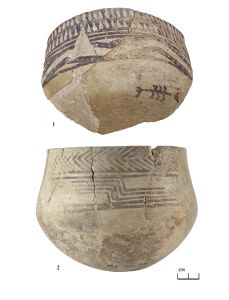 Natalia Yu. Petrovaa,#, Galina Yu. Kolganovab,##, Marina A. Titovac,###
Natalia Yu. Petrovaa,#, Galina Yu. Kolganovab,##, Marina A. Titovac,###
a Institute of Archaeology RAS, Moscow, Russia
b The Pushkin State Museum of Fine Arts, Moscow, Russia
c Independent researcher, Moscow, Russia
#Е-mail: petrovanatalya7@mail.ru
##Е-mail: kolganova_gy@mail.ru
###Е-mail: malinkolie@rambler.ru
Keywords: Standard Hassuna, Samarra, Upper Mesopotamia, Neolithic pottery technology.
The article overviews the distribution of Neolithic pottery of the Standard Hassuna period in Upper Mesopotamia: from the foothills of the Taurus in the north to approximately the region of the Diyala river in the south; from the foothills of the Zagros in the east to the Balikh river, or possibly as far as the Euphrates river, in the west. In addition, the pottery of the Standard Hassuna (or the influence of this pottery tradition) is recorded in the hinterland of the Zagros. Based on the materials of the Yarim Tepe I settlement from the collection of the Pushkin State Museum of Fine Arts, the paper examines technological features of the Standard Hassuna pottery. They demonstrate a connection with the pottery technology of the previous periods of the Hassuna culture – Proto-Hassuna and Archaic Hassuna: the presence of an organic plant admixture (dung) in the pottery paste of a part of the vessels and the use of a two-layer slab construction. The innovations include the use of a light slip, as well as the improvement in the quality of firing, associated with the significant development of firing devices at that time. It is possible to assume the appearance of pictographic images on the Samarra pottery represented on the site as items of import.
DOI: 10.31857/S0869606323010154







